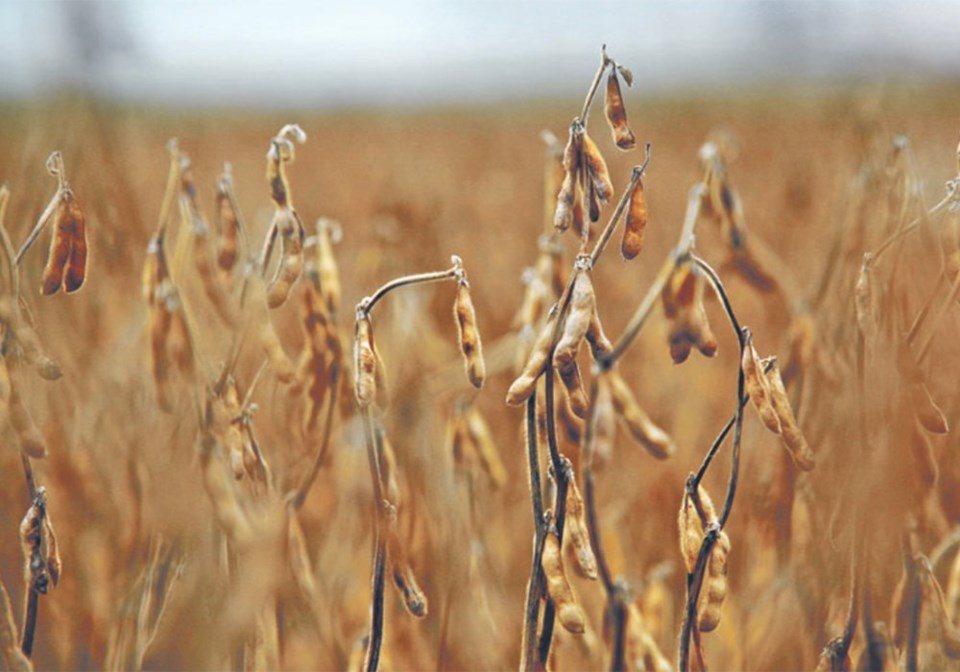Every year the Oxford Dictionary adds words and phrases to its publication.
In 2021 for instance, one of new phrases was “gig economy.”
In 2023 or 2024, the Oxford folks may want to consider a new word that’s gaining traction in southeastern Saskatchewan.
The word? Soy-fallow.
“A few guys coined the term around here,” said Mark Alexander, who farms south of Weyburn, Sask. “You always get a really good crop on the soybean stubble the next year.”
Soy-fallow doesn’t have an official definition. But if it did, the definition might be: growing soybeans so the following crop is successful.
“(You get) fantastic durum or whatever you grow on it the next year. It seems to have a really good yield bounce,” said Alexander, who seeded 1,140 acres of soybeans on his farm this spring.
Alexander is among a small number of Saskatchewan growers who still have faith in soybeans.
In 2017, Saskatchewan farmers seeded 850,000 acres of beans and some predicted that acres would reach two million, or more, in the 2020s.
That didn’t happen.
Instead, acres went the other direction – dropping to 400,000 in 2018, 150,000 acres in 2020 and 85,000 in 2021.
Years of drought, especially lack of rain in August, decimated soybean yields in the province. Many producers recorded yields of 10 to 15 bushels per acre. That sort of yield doesn’t pay the bills and most producers abandoned beans in favour of other crops.
“We can’t get the yield out of them,” said Howie Mercer, FarmLink marketing adviser in southeastern Saskatchewan, in 2019. “We don’t get the rains when we need them.”
Statistics Canada predicted that Saskatchewan farmers will plant about 40,000 acres of soybeans this year –the lowest amount in the last 12 years.
Winston Van Staveren, who farms near Creelman, Sask., continued to grow the legume in the drought years of 2017 to 2021 – but he didn’t plant soybeans this spring.
Van Staveren will grow soybeans in the future, but the economics didn’t pencil out in 2022.
The price and potential returns for other crops, were too appealing.
“Acres (in Saskatchewan) have slimmed down. In my opinion, they’ve probably bottomed out,” he said.
Many producers have turned their back on beans, but Alexander decided they made sense on his farm for agronomic reasons.
He just added a new piece of land (about two sections) to his operation, but the land was covered in weeds “from corner to corner.”
Soybeans were the right choice for the weedy field because herbicide can be applied during the growing season.
He sprayed glyphosate and Heat prior to seeding and will spray again this spring.
“Because of the thistle on it… this way we can hit it with two shots of glyphosate (in crop) to keep it in reasonably clean condition.”
Plus, there’s the ‘soy-fallow’ benefit – where the soybeans may boost the subsequent crop on the same land.
“It was 70 percent agronomics on this land we took over, on why we put it in,” he explained.
“Thirty percent was: we (could) get a decent yield at a decent price.”
As of early June, new crop soybeans were trading around US $16 per bu. on the Chicago futures market.
Alexander doesn’t expect a huge yield from his beans. But if he gets something, say 20 bu. per acre, that could generate revenue of $400 per acre in 2022.
That’s lower than the potential returns from canola. But soybeans have lower input costs.
Alexander’s approach to soybeans is more like a rotational crop; something he plants to manage weather risk and provide agronomic benefits for the overall production system.
Soy Canada, the industry association, needs more growers like Alexander. The group hopes to expand national production and most of that expansion can only happen on the Prairies because Ontario is maxed out for beans.
Soy Canada has a target of six million acres on the Prairies by 2027. That’s an ambitious goal, considering that 1.25 million acres were planted in Manitoba and Saskatchewan in 2021.
Still, if more growers start to view soybeans as ‘soy-fallow’ or a rotational crop, acres could rebound in Saskatchewan.
“I never plant them thinking (it’s) going to be my money maker,” Alexander said. “We grow red lentils and soybeans. We don’t want rain in August for the red lentils. But if we do get wet, the soybeans will love it. You’re always trying to hedge your risk…. (And) right now my soybean stubble from last year, I have canola on (that field). It looks just fantastic…. When you factor in all these things, it still has a fit somewhere in the crop rotation.”




